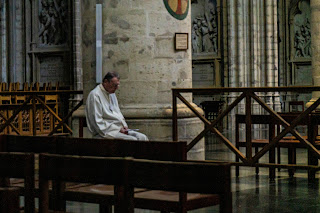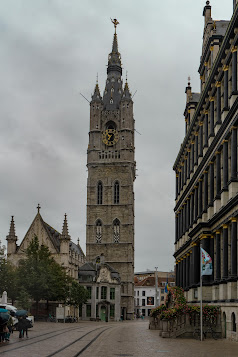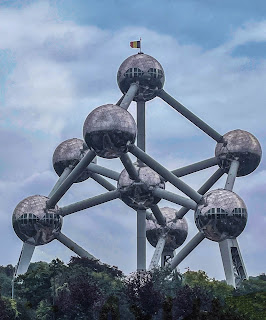Royal Museums of Fine Arts of Belgium
When in Brussels it is necessary to visit the museums, given that they have gone to so much trouble to put them all together in one place. We managed to visit two of the Royal Museums of Fine Arts of Belgium - the Art and History Museum with a good collection of Dutch and Flemish works and the Rene Magritte Museum - based on the work of Magritte a Belgian Surrealist - over the course of one day. I am focusing here on the first one. You need to see the Magritte Museum for yourself.
One needs a theme to survive such a day and I decided to look for details in the paintings. I hit upon this idea when we saw a short film on Bruegel’s “The Census at Bethlehem” which focused on a number of small details in the painting including
a woman stealing vegetables from someone’s garden,
 |
| You can see here leaning over the fence at the back |
Mary on a donkey, looking different from everyone else in the picture, Joseph who proved he was a carpenter by bring his saw to the census
 |
| why would you bring your saw? |
and a range of other totally unrelated scenes including the slaughter of a pig. So inspired, I started looking for details in all the paintings and discovered the murderer of St Livinius feeding his tongue to his dog,
 |
| can't waste a good tongue |
a puppy waiting for drops of blood from a slaughtered boar,
and a scary woman who was on the losing side during the fall of the rebel angels.
 |
| Pretty impressive elbow flexibility |
One other notable painting that managed to find its way here is the murder of Marat painted by David. It is lucky that it was displayed here, because there has not been any tendency to "Revolution Wash" the painting. Marat was not a nice man, responsible for the deaths of many in the reign of terror after the revolution. His assassin was a woman who claimed he was responsible for the death of one of her family members and she was happy to take him out as her last act.
 |
| you have seen it before but look as the signature |
David, who had made a career in painting large propaganda scenes over the years had managed to become a favoured painter of the revolutionaries and he cemented this by painting Marat as a hero. The commentator in the audio guide felt this was inappropriate and pointed out the many flaws in the representation, the least of which is the dedication above David's name, "A Marat" (to Marat). I am sure they were good mates before 1789.
 |
| At least as many women as men in the wings and more in the main panel |
 |
| A mother protecting her child |
That said, later in the week we did visit the museum of Brussels and there were two exhibits that did stand out – both men. Louis IVX, you can call him the sun king, and a knight. Louis (we are on first name terms) stood out because the surrounding information pointed out that all the glorifying historical information you find in France fails to point out that he willfully and without provocation, ordered the Grand Plaza in Brussels to be burnt to the ground. The Brusselians (my word) had the last laugh because they rebuilt it almost immediately in stone and it still stands today.
The knight? Well, I just liked his attitude.

























